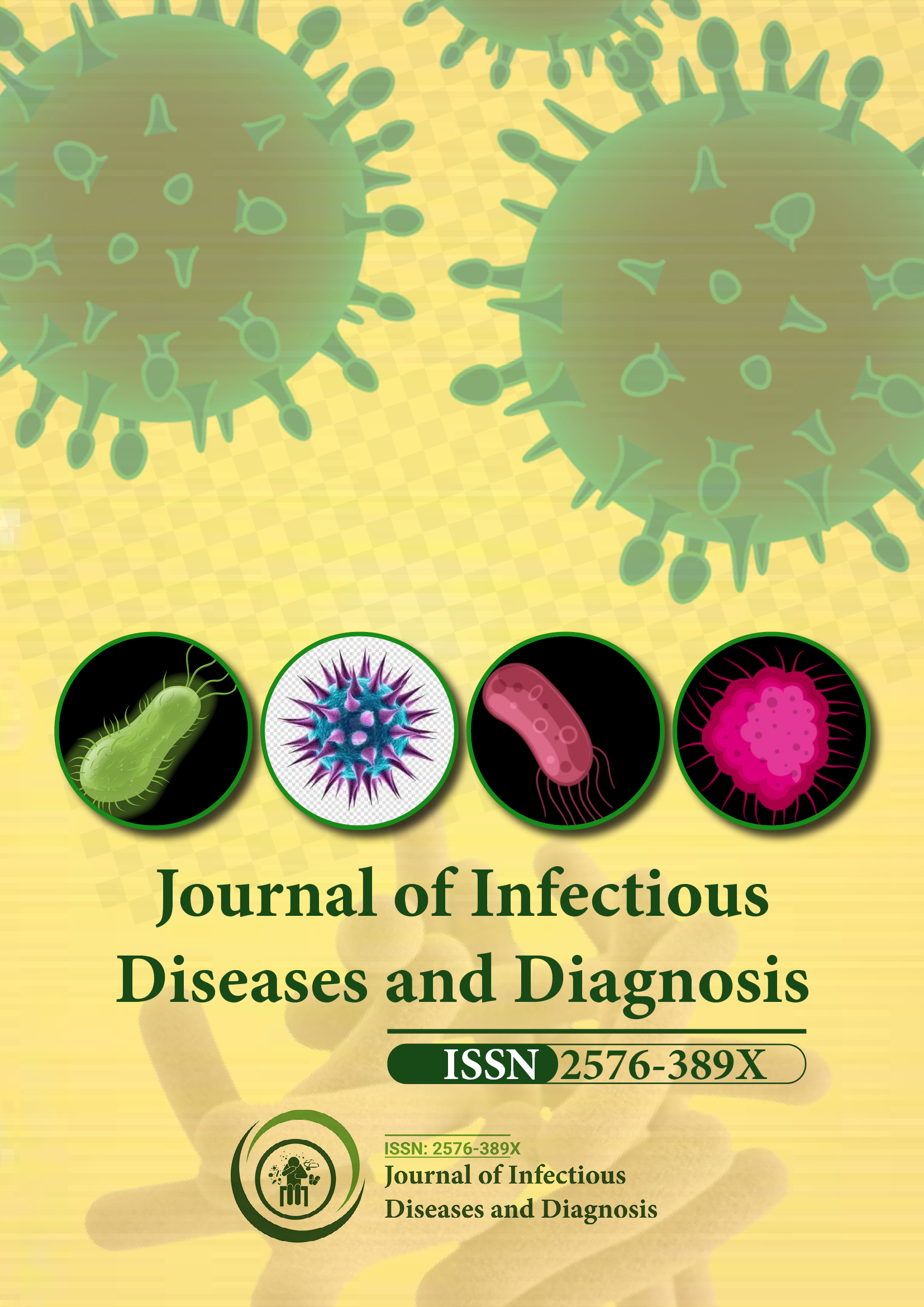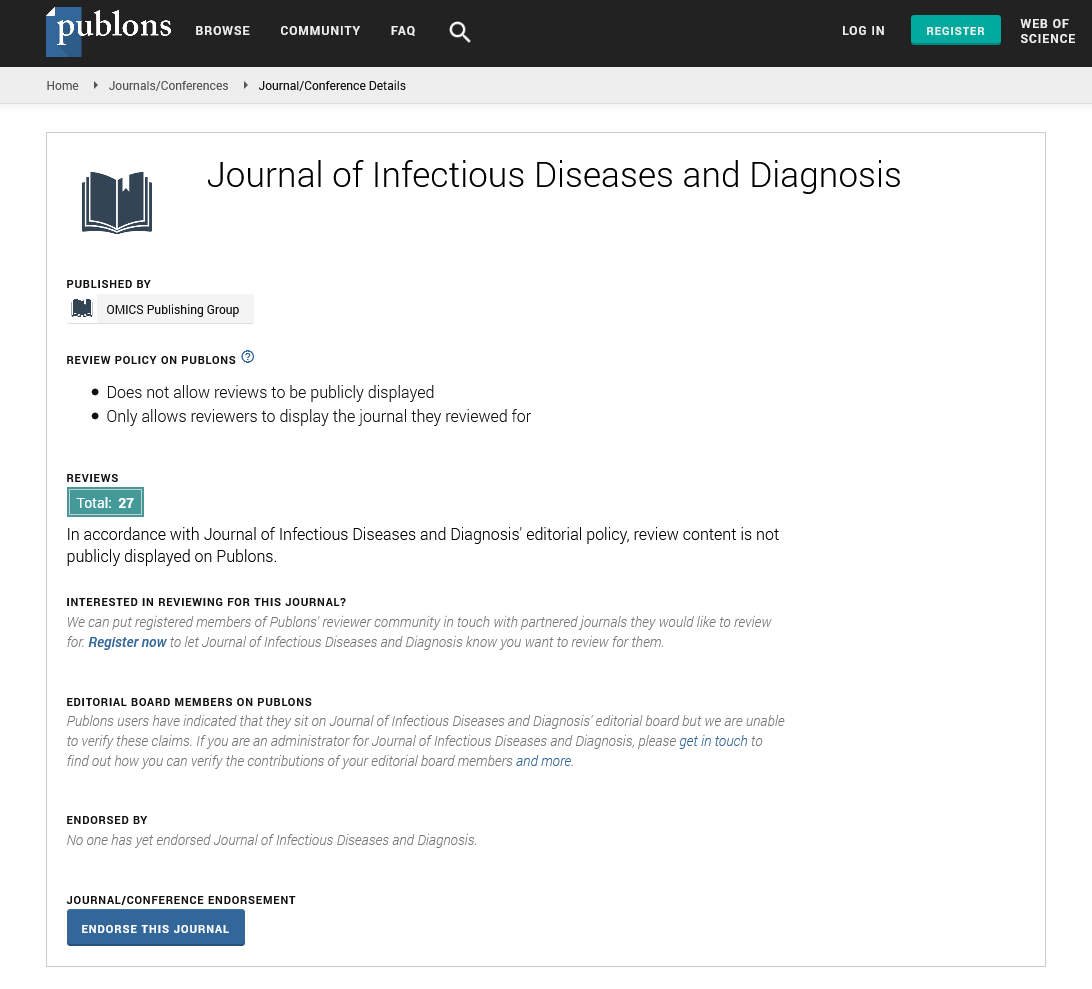Indexed In
- RefSeek
- Hamdard University
- EBSCO A-Z
- Publons
- Euro Pub
- Google Scholar
Useful Links
Share This Page
Journal Flyer

Open Access Journals
- Agri and Aquaculture
- Biochemistry
- Bioinformatics & Systems Biology
- Business & Management
- Chemistry
- Clinical Sciences
- Engineering
- Food & Nutrition
- General Science
- Genetics & Molecular Biology
- Immunology & Microbiology
- Medical Sciences
- Neuroscience & Psychology
- Nursing & Health Care
- Pharmaceutical Sciences
Commentary - (2024) Volume 9, Issue 6
Cholera: Pathogenesis, Diagnosis and Global Strategies for Prevention and Control
Lewin Paul*Received: 28-Oct-2024, Manuscript No. JIDD-24-27708; Editor assigned: 30-Oct-2024, Pre QC No. JIDD-24-27708 (PQ); Reviewed: 14-Nov-2024, QC No. JIDD-24-27708; Revised: 21-Nov-2024, Manuscript No. JIDD-24-27708 (R); Published: 29-Nov-2024, DOI: 10.35248/2576-389X.24.09.300
Description
Cholera is a waterborne disease caused by Vibrio cholerae, predominantly affecting regions with inadequate sanitation and water infrastructure. This disease manifests as acute watery diarrhea, leading to severe dehydration and death if untreated. Effective management requires prompt diagnosis and appropriate rehydration therapy. Cholera remains a significant public health issue, with millions of cases reported annually worldwide. The disease is particularly problematic in areas experiencing natural disasters, humanitarian crises, or other conditions that lack water quality and sanitation. Vibrio cholerae, the causative organism, thrives in brackish water and coastal regions, often proliferating during warm seasons. Cholera outbreaks occur sporadically, but endemic regions, particularly in South Asia and Sub-Saharan Africa, bear the brunt of its burden.
Pathogenesis
The pathogenic mechanism of cholera begins with the ingestion of contaminated water or food containing V. cholerae. The bacterium colonizes the small intestine, facilitated by its flagella and mucinase enzymes, which help it navigate the gut environment. Once established, V. cholerae produces Cholera Toxin (CT), an enterotoxin that disrupts ion transport in intestinal epithelial cells.
Epidemiology
Cholera has a long history of pandemics, with the seventh and most recent pandemic caused by the El Tor biotype of V. cholerae O1. The disease is endemic in many parts of Asia and Africa, where poor access to clean water and sanitation systems exacerbates its spread. Climate change, urbanization and population displacement contribute to the persistence and resurgence of cholera in these regions.
The World Health Organization (WHO) estimates that up to 4 million cholera cases occur annually, with tens of thousands of deaths. Children under five are particularly vulnerable, accounting for a significant proportion of cases and fatalities. Vaccination campaigns and improved public health measures have reduced the incidence in some areas, but outbreaks continue to occur.
Clinical presentation
Cholera's clinical spectrum ranges from asymptomatic carriage to severe disease. Mild cases may resemble other forms of gastroenteritis, while severe cases are characterized by acute, painless diarrhea and vomiting, leading to rapid dehydration. Patients with severe dehydration may present with sunken eyes, dry mucous membranes, hypotension, tachycardia and reduced urine output. Without intervention, severe cases can progress to hypovolemic shock and multi-organ failure.
Diagnosis
Accurate and timely diagnosis is essential for managing cholera and preventing its spread. The following methods are commonly used:
Clinical diagnosis: In endemic areas, cholera is often diagnosed clinically based on symptoms, especially during outbreaks. Acute watery diarrhea with signs of dehydration in a person exposed to contaminated water strongly suggests cholera.
Microscopy and culture: Stool samples can be examined microscopically for the characteristic "darting" motility of V. cholerae. Culture on selective media, such as Thiosulfate-Citrate-Bile Salts-Sucrose (TCBS) agar, confirms the presence of the pathogen. Colonies appear yellow due to sucrose fermentation.
Rapid Diagnostic Tests (RDTs): RDTs have become valuable in resource-limited settings. These tests detect V. cholerae antigens in stool samples, providing results within minutes. Although less specific than culture, they are useful during outbreaks for quick identification.
Molecular techniques: Polymerase Chain Reaction (PCR) is a sensitive method for detecting V. cholerae DNA in stool samples. It can identify specific serogroups, such as O1 and O139 and distinguish toxigenic strains. PCR is primarily used in research and well-equipped laboratories.
Serological tests: Serological methods detect antibodies against V. cholerae in patient serum. These tests are less commonly used for diagnosis but can help in epidemiological studies to assess population exposure.
Treatment and management
The primary treatment for cholera is Oral Rehydration Therapy (ORT) to replace lost fluids and electrolytes. Severe cases require intravenous fluids and close monitoring. Antibiotics, such as doxycycline or azithromycin, may reduce the duration of diarrhea and bacterial shedding but are secondary to rehydration. Zinc supplementation has been shown to improve outcomes in children.
Public health measures, including access to clean water, proper sanitation and health education, are vital for preventing cholera. Vaccines, such as Oral Cholera Vaccines (OCVs), provide additional protection in endemic areas and during outbreaks.
Prevention and control
Prevention of cholera involves improving water and sanitation infrastructure, promoting hand hygiene and educating communities about safe food and water practices. Surveillance systems are essential for early detection and containment of outbreaks. Mass vaccination campaigns using OCVs have proven effective in reducing the incidence of cholera in high-risk populations.
Conclusion
Cholera remains a significant challenge in global health, particularly in low-resource settings. Advances in diagnostic methods, coupled with effective treatment and prevention strategies, have reduced its impact in some regions. However, sustained efforts to improve water and sanitation, enhance surveillance and expand access to vaccines are necessary to eliminate cholera as a public health threat. Addressing these priorities will save lives and improve resilience against future outbreaks.
Citation: Paul L (2024). Cholera: Pathogenesis, Diagnosis and Global Strategies for Prevention and Control. J Infect Dis Diagn. 9:300.
Copyright: © 2024 Paul L. This is an open-access article distributed under the terms of the Creative Commons Attribution License, which permits unrestricted use, distribution and reproduction in any medium, provided the original author and source are credited.

